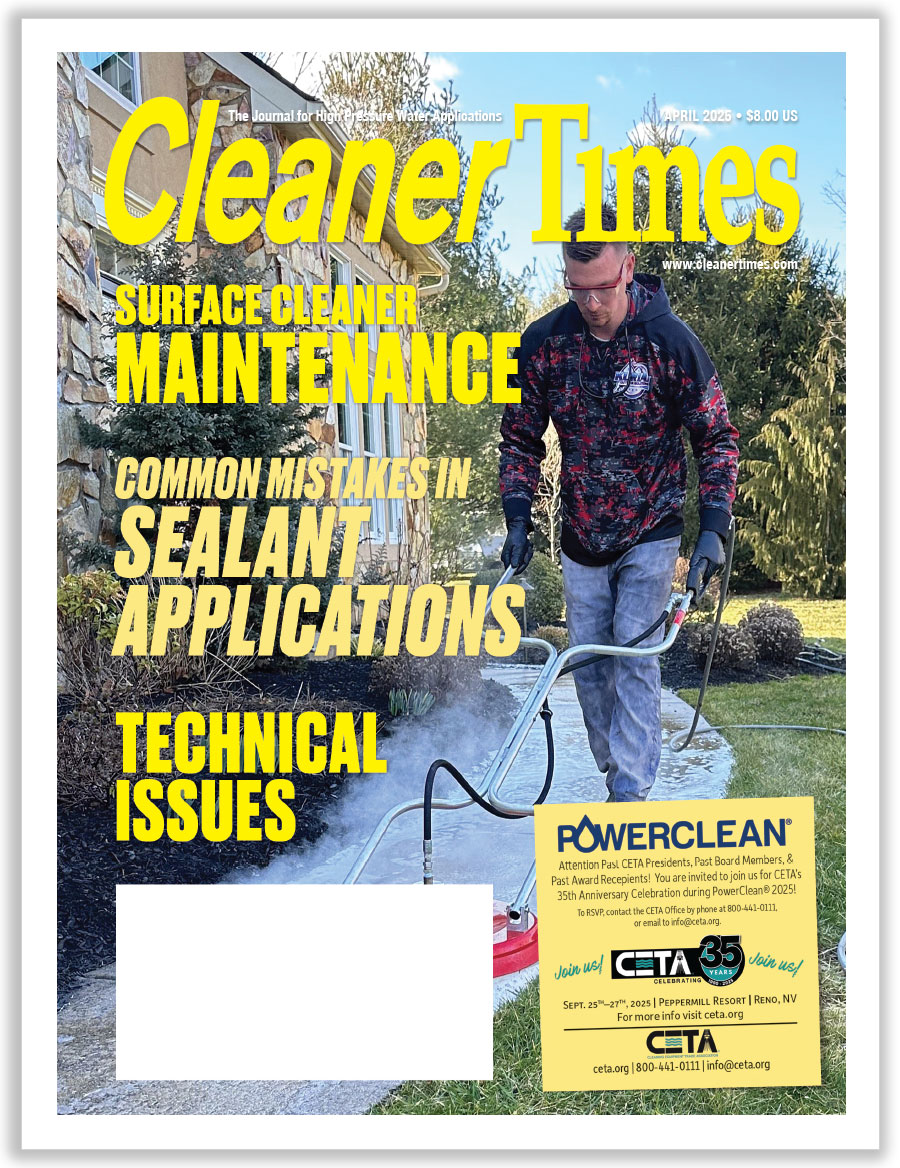
Cleaning Funeral Homes and Cemeteries
By Diane M. Calabrese / Published July 2017

“We owe God a death. If we pay it today, then we don’t owe it tomorrow… Shakespeare encapsulated it nicely in Henry IV. Death is inevitable, a part of life’s path. Knowledge of one’s end of days on earth should instill courage, not fear.
Do what must be done—do the right thing—and the rest will take care of itself. So it was in the film, Only Angels Have Wings (1939), when a medical doctor took a risky flight to save an ill child. He quoted Shakespeare (in Spanish) when told of the danger of making the trek.
Belief and perspective aside, a sense of loss cannot be brushed away when someone dies. We miss the presence of our friends and loved ones. For many, a funeral is a way to pause and reflect. A burial with a grave marker is a way to remember.
Quiet prevails at funeral homes and cemeteries. The quietude contributes to comfortable and comforting surroundings. Yet, funeral homes and gravestones require maintenance, including cleaning. To enter either setting to perform cleaning tasks is to take on a special responsibility to curtail unnecessary disruption.
Consider funeral homes. “We have cleaned a few funeral home exteriors,” says Henry Bockman, president of Commercial Restorations in Germantown, MD. “The biggest challenge with them is scheduling the job.” Put the emphasis on being flexible. “If there is a service, we can’t perform the job,” says Bockman. “In most cases, we have to schedule and reschedule the work four or five times because of a death in the area.” Despite the complexity of finding a guaranteed time to do the work, Bockman carries on. He enjoys finding solutions to problems.
“I have lost some bids because I bid them much higher than other companies,” explains Bockman. “But I enjoy performing jobs that other companies could not figure out how to do, or how to overcome some of the obstacles to get the job done.”
Moving to gravestones in cemeteries, there are other challenges. “We have cleaned mausoleums, retaining walls, bridges, statues, and other items in cemeteries,” says Bockman. “The only special precautions for most of these items is we have to be careful to avoid water leaking into mausoleums, so we perform a thorough inspection of the structure before we estimate it and clean it.”
Taking care to assess the condition of a structure and how to approach it when cleaning applies to all projects. It is especially important when cleaning grave makers.
“The markers, which are usually made from limestone, sandstone, and marble, can have hairline fractures and heavy biological growth which can easily result in damage to the markers,” says Bockman. The condition of many markers may not be the best because the markers have been ignored for years or decades.
“Usually the two problems we find the most challenging are water access and neglect of markers,” explains Bockman. But the problems are solvable. Entry into the funeral market niche requires preparation. “Cleaning and restoring limestone, sandstone, and marble is very time consuming and requires a lot of testing to determine the best cleaning solution and process,” says Bockman.
Take the time to learn. “Having the training and knowledge to repair cracks and other damages is very valuable,” says Bockman. “I took a restoration course from Cathedral Stone that trains you how to repair statues and damages using Jahn Masonry for almost any type of stone and mortar surface, which has been invaluable.”
Opportunities
We spoke with a few contractors who clean stone and who are giving serious consideration to offering services to clean grave markers. One veteran contractor believes that is likely to be a good decision. He explains his assessment and its context.
“Our most famous cleaning came when my guys were cleaning a massive granite mausoleum,” says John Tornabene, owner of Clean County Powerwashing in Kings Park, NY. “The small tombstone behind it that was covered in mold just happened to be Babe Ruth’s, one of the most visited tombstones in the country.” It was distressing to see the marker in such a condition. “So, we took the risk and cleaned that also because Ruth shined in life so he should shine in death as well,” says Tornabene.
“That granite mausoleum cleaning paid us very well, which is why we were willing to travel 90 minutes to get there, says Tornabene. “We don’t advertise to clean tombstones, but I’m sure it can be a lucrative business if one has an interest in cleaning them.”
When evaluating opportunities, one can also go by the raw numbers. In 2017, the number of funeral homes in the United States is estimated at 19,322 (source: National Directory of Morticians Redbook).
One caution regarding approaching cemeteries for work cleaning grave markers is that most cemeteries are not locally owned. Four big companies that own both funeral homes and cemeteries are Service Corp International (Houston, TX), Stewart Enterprises (New Orleans, LA), Carriage Services (Houston, TX), and Keystone North America (Tampa, FL). (Source of information is www.gravemarkers.info/Big-Business-of-Cemeteries-information.php.) Start with the big companies to get some idea of what they look for in a contractor. Also, try to get on bid notification lists that are available.
Nothing remains static, and the National Funeral Directors Association projects that by 2030 cremation will be much more common than burial, at 71.1 percent to 23.2 percent. In 2017, the breakdown is expected to be 51.6 percent to 42.3 percent. Cremation does not preclude burial of ashes and a marker, so there will continue to be a significant number of gravestones.
Another change that may depress the number of markers and funeral homes over time is the trend toward green burial, which begins with embalmment-free and metal-coffin-free bodies and then varies from bodies in wooden boxes to bodies wrapped merely in vegetation. The green burial advocates argue strenuously that there is no danger of communicable disease from such practices, save if someone died from a highly contagious virus that persists after death (e.g. Ebola).
Why not choose cremation instead of green burial? Many advocates fret about carbon dioxide emissions from the cremation. Is there not a problem with contributing organic pollutants (blood, etc.) to ground water? The many analyses we read simply ignore the possibility.
Obligations
Learn how to do it correctly if it’s a gravestone that will be cleaned. There’s abundant assistance available, thanks to the many societies focused on preservation of grave markers either because of interest in historic preservation or genealogy.
A particularly good place to start learning is the “How to Protect and Preserve a Gravestone?” publication from the International Southern Ceme-tery Gravestones Association (www.iscga.org). The ISCGA publication reemphasizes the advice from Bockman to determine the condition of the marker before devising a way to clean it.
The ISCGA does not recommend jumping in and using a pressure washer on a gravestone. The fragility of many old markers precludes it. On the other hand, the use of a pressure washer on a gravestone that has full integrity is fine, particularly if the stone does not have fine engraving.
The recommendations from the association for ridding a stone of lichen and algal growth illustrate the time it may take to do the job correctly. For example, lichens may be removed by hand scrubbing with a mixture that is four parts water and one part ammonia, followed by a water rinse. Another alternative is a hand scrubbing using equal parts water and glycerin.
There’s much to learn from the ISCGA publication. The “common myth” dispelled, that a gravestone could be cleaned with shaving cream, makes us wonder if any contractors have heard it.
On the basics side, the recommendation from the association for granite headstones, which are common among more recent markers, is clean water (natural preferred), a non-ionic detergent, and a biocidal cleaning agent. Not all grave markers are stone, and there are also recommendations given for cleaning those that are bronze, such as soft scrubbing with a dish-soap solution.
For contractors who wish to learn about restoration as well as cleaning methods, a good starting point is the information provided by Jahn Inter-national (www.jahn-international.com/en/info). Headquartered in the Netherlands, the company has developed restoration techniques across extreme climatic conditions. Moisture-regulation, frost-resistant, salt-resistant, and custom-made mortars are integral parts of the company’s product roster.
The flipside of grave markers that have been left to languish are those that are tended too carefully. Recom-mendations for cleaning stone markers vary from no more than once every two years to once every 10 years.
The quiet of the funeral home and cemetery setting becomes even more of a comfort to visitors when there are no visual distractions. Cleaning contractors working in the settings eliminate visual noise—dirt, biological debris and growth, etc.—adding to peacefulness.
There are most definitely opportunities to clean funeral homes and cemeteries. Contractors willing to learn and work within the constraints of a very special setting—one in which people are dealing with loss—are likely to find many challenging and rewarding projects.





